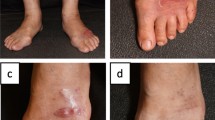Abstract
A 40-year-old woman presented with a skin disease, characterized by confluent erythematous nodules and purulent material discharges, which affected the right arm. A Ziehl–Nielsen stain of purulent material revealed the presence of acid-fast bacilli. The isolated microorganism was identified by standard biochemical procedures as a member of the Mycobacterium fortuitum group. Molecular identification performed by amplification and sequencing of the 16S rRNA revealed 100% identity with strains of M. fortuitum. The following report reveals an extensive cutaneous affection caused by M. fortuitum in a non-predisposed immunocompetent patient.


Similar content being viewed by others
References
Streit M, Bregenzer T, Heinzer I (2008) Hautinfecktionen durch atypische Mycobakterien. Hautarzt 59:59–71
Wallace R, Brown B, Griffith D (1998) Nosocomial outbreaks/pseudo outbreaks caused by nontuberculous mycobacteria. Annu Rev Microbiol 52:453–490
Gürtler V, Harford C, Bywater J, Mayall B (2006) Direct identification of solely growing Mycobacterium species by analysis of the intergenic 16S-23S rDNA spacer region (ISR) using a GelCompar II database containing sequence based optimization for restriction fragment site polymorphisms optimization for restriction fragment site polymorphisms (RFLPs) for 12 enzymes. J Microbiol Methods 64:185–199
Adékambi T, Drancourt M (2004) Dissection of phylogenetic relationships among 19 rapidly growing Mycobacterium species by 16S rRNA, hsp65, sodA, rec A and rpoB gene sequencing. Int J Syst Evol Microbiol 54:2095–2105
Schinsky MF, Morey RE, Steigerwalt AG (2004) Taxonomic variation in the Mycobacterium fortuitum third biovariant complex: description of Mycobacterium boenickei sp nov., Mycobacterium houstonense sp. nov., Mycobacterium neworleansense sp. nov. and Mycobacterium brisbanense sp. nov. and recognition of Mycobacterium porcinum from human clinical isolates. Int J Syst Evol Microbiol 54:1653–1667
Reilly AF, McGowan KL (2004) Atypical mycobacterial infections in children with cancer. Pediatr Blood Cancer 43:698–702
Han XY, Dé I, Jacobson KL (2007) Rapidly growing mycobacteria clinical and microbiologic studies of 115 cases. Am J Clin Pathol 128:612–621
Lazzarini L, Amina S, Wang J, Calhoun JH, Mader JT (2002) Mycobacterium tuberculosis and Mycobacterium fortuitum osteomyelitis of the foot and septic arthritis of the ankle in an immunocompetent patient. Eur J Clin Microbiol Infect Dis 21:468–470
National Committee for Clinical Laboratory Standards (1998) Performance standards for antimicrobial susceptibility testing; eighth informational supplement. M100-S8. National Committee for Clinical Laboratory Standards, Wayne
Sommerville W, Thiebert L, Schwartzman K, Behr MA (2005) Extraction of Mycobacterium tuberculosis DNA: a question of containment. J Clin Microbiol 43:2996–2997
Palenque E (2000) Skin disease and nontuberculous mycobacteria. Int J Dermatol 39:659–666
Vaerewijck MJ, Huys G, Palomino JC, Swings J, Portaels F (2005) Mycobacteria in drinking water distribution systems ecology and significance for human health. FEMS Microbiol Rev 29:911–934
Vinh DC, Rendina A, Turner R, Embil JM (2006) Breast implant infection with Mycobacterium fortuitum group: report of case and review. J Infect 52:e63–e67
Chetchotisakd P, Mootsikapun P, Anunnatsiri S, Jirarattanapochai K, Choonhakarn C, Chaiprasert A et al (2000) Disseminated infection due to rapidly growing mycobacteria in immunocompetent hosts presenting with chronic lymphadenopathy: a previously unrecognized clinical entity. Clin Infect Dis 30:29–34
Bartralot R, García-Patos V, Sitjas D, Rodriguez-Cano L, Mollet J, Martin-Casabona N et al (2005) Clinical patterns of cutaneous nontuberculous mycobacterial infections. Br J Dermatol 152:727–734
Bartralot R, Pujol RM, García-Patos V, Sitas D, Martin-Casabona N, Coll P et al (2000) Cutaneous infections due to nontuberculous mycobacteria: histopathological review of 28 cases; comparative study between lesions observed in immunosuppressed patients and normal hosts. J Cutan Pathol 27:124–129
Arenas R, Veja-Memije ME, Tomoka MT, Domínguez Cherit J, Carbajosa J, Cortes F et al (1993) Micobacteriosis atipicas. Aspectos clinico-epidemiologicos de 44 casos. Dermatol Rev Mex 37:305–315
Hemmersbach-Miller M, Cárdenas-Santana MA, Conde-Martel A, Bolaños-Guerra JA, Campos-Herrero MI (2005) Cardiac device infections due to Mycobacterium fortuitum. Can J Infect Dis Med Microbiol 16:183–185
Uslan DZ, Kowalski TJ, Wengenack NL, Virk A, Wilson JW (2006) Skin and soft tissue infections due to rapidly growing Mycobacteria. Comparison of clinical features, treatment and susceptibility. Arch Dermatol 142:1287–1292
Tortoli E (2003) Impact of genotypic studies on mycobacterial taxonomic: the new mycobacteria of the 1990’s. Clin Microbiol Rev 16:319–354
Acknowledgments
No funds were received in support of this study.
Conflict of interest statement
No benefits in any form have been or will be received from a commercial party related directly or indirectly to the subject of this manuscript. The authors declare that they have no conflict of interest.
Author information
Authors and Affiliations
Corresponding author
Rights and permissions
About this article
Cite this article
Rangel-Gamboa, E.L., Hernández-Castro, R., Arenas, R. et al. Mycobacterium fortuitum associated with fasciotomy in an immunocompetent patient. Eur J Orthop Surg Traumatol 20, 71–74 (2010). https://doi.org/10.1007/s00590-009-0490-2
Received:
Accepted:
Published:
Issue Date:
DOI: https://doi.org/10.1007/s00590-009-0490-2




